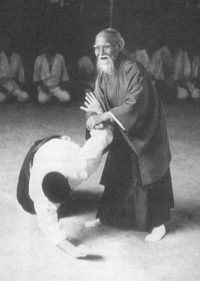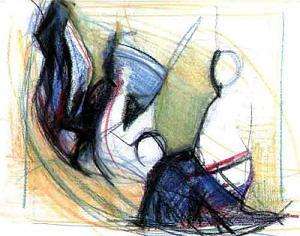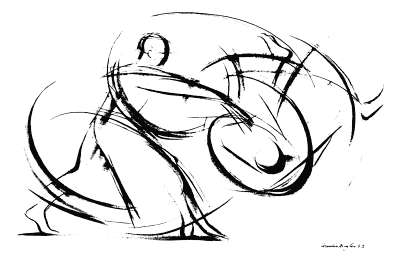John Hannon
WaccoBB.net
Part 1 of 5: Introduction
An old Cherokee is teaching his grandson about life:
A fight is going on inside me, he said to the boy. It is a terrible fight and it is between two wolves. One is evil - he is anger, envy, sorrow, regret, greed, arrogance, self-pity, guilt, resentment, inferiority, lies, false pride, superiority, and ego. The other is good - he is joy, peace, love, hope, serenity, humility, kindness, benevolence, empathy, generosity, truth, compassion, and faith. This same fight is going on inside you - and inside every other person, too.
The grandson thought about it for a minute and then asked his grandfather, Which wolf will win?
The old Cherokee simply replied, The one you feed.
The conflict that we see in the world around us is a reflection of the conflicts with in us. It may, at times, feel as though conflict seeks us out and challenges us beyond our capacity for harmony. It is in these moments of challenge that we are tested and to one degree or another succeed or fail. It has been said that the natural state of this objective universe isharmony and that only in subjective reality is there conflict. As humans, we co-exist in an objective reality while, for the most part being completely driven by our subjective experiences. It is the collision of these subjective experiences that proliferates the suffering between us and it is likely that the motive of our every act is an attempt to alleviate this suffering for ourselves.
At first, one might consider the martial arts to be practices that thrive on and proliferate conflict. There is no doubt that they have this potential, however, the martial arts should be understood more deeply than this. For, while they are outwardly martial, traditional martial arts have great potential to be inwardly pacifying by building self-confidence in the face of conflict and therefore preemptively conflict resolving in nature. It is my belief that the true goal of the martial artist is the pursuit of peace within and outside of oneself.
The martial art of aikido is particularly suited as a practice to develop the skills of conflict resolution. It is often called The Art of Peace and was envisioned by its founder, Morihei Ueshiba (1883-1969) as a practice capable of healing the world of dissonance and strife. He called aikido, “medicine for a sick world”, for it is meant to develop peace, strength, confidence, and compassion for oneself and for others. Ideally the practice of aikido is done in a non-competitive environment and develops the personal philosophy of those who practice it in a way that shapes their life outside of the dojo.
First and foremost in the practice of aikido is the goal and sincere interest in not fighting. Now this sounds like an oxymoron to most people, since aikido is qualified as a martial art. It is sometimes difficult to convince people that in fact aikido is not a method of fighting. Aikido ends the fight or conflict… preferably before it starts. This is the philosophy upon which all of the others principles are based. If you really want to practice aikido, the art of peace, you can’t be looking for or accepting a fight. Instead, you have to dedicate yourself to developing an awareness and sensitivity that will keep your spirit out of conflict in the first place. Become aware of danger zones (physical, mental and emotional). Try to understand your blind spots and buttons (again physical, mental and emotional). Be courteous, and friendly without being naive. These things go a long way to help maintain peace within and without.
Just about every aspect of aikido can be applied to one’s daily life. In that way it is no different than any practice one dedicates oneself to. However, because of the non-competitive nature of aikido the rewards of practice are far less likely to be conditional on the winning or beating of another practioner. Aikido is fundamentally a training in conflict resolution so its capacity to create harmony in the lives of those touched by it directly or indirectly is of great benefit to the health of society.
While this series will offer tips on how to use aikido principles to resolve conflict in everyday conflict situations the physical practice of aikido provides a tangible and experiential method to feel these principles work. It is very difficult to replace the physical practice of aikido with words and theories. I recommend the practice of aikido to everyone, because its benefits are substantial and available to anyone. But, if you are uninterested in joining a local dojo, you can at least try your best to apply the following aikido principles to your life and see how they work. I don’t doubt that good will come of it.
The next four articles in this series will explain The Four Principles of Mind and Body Coordination that were systematized by Koichi Tohei (1920-2011) a tenth dan (tenth degree blackbelt) and one-time head instructor at the Aikido Headquarters in Japan. Koichi Tohei eventually left the world of martial arts training to dedicate himself solely to the development of ki. Ki (the second syllable in the word aikido) refers to the vital force of the universe. The practice of aikido trains one to harmonize this vital force in the face of physical violence however, as Koichi Tohei proved throughout his life, one need not train in aikido as a martial art to benefit from the development of ki.
The Four Principles are:
The Four Principles of Mind-Body Coordination offer a framework by which to develop and harmonize the vital force of ki in your daily life. Through dedicated pursuit of these four principles one can gain physical, mental, emotional and spiritual health. Each of the following articles will offer insights, exercises and anecdotes illustrating the principles. The goal is to help readers begin to apply the principles so as to experience some of the benefits of aikido practice without necessarily stepping inside a dojo.
- Keep One Point
- Relax Completely
- Keep Weight Underside
- Extend Ki
Even though each article will concentrate on an individual principle it is important to explain that the four principles are not really separate practices. They are in fact completely interdependent. To employ one principle means that you are to some degree employing them all. For instance, there is no way to extend ki, without being relaxed, centered andgrounded. There is no way to be relaxed without, extending ki, keeping one point and keeping your weight underside. The degree of success you experience with each of the principles will determine overall success with the four.
Also, it is important to understand that the quality of the energy you put into the practice determines the quality of its output. To develop a healthy and coordinated mind-body through the practice of the Four Principles begin by clarifying your intention for doing so. To gain the benefits of the practice of aikido on or off the mat you must be committed to the process of purification. Just as a healthy diet nurtures and purifies the physical body, so does a healthy intention for the development of ki nurture and purify a healthy energy and spirit. Without this positive intention the practice will not yield positive results. The Four Principles are dependent on the sincere desire for self-betterment and a commitment to develop, maintain, and promote positive and beneficial ki in yourself and in the world around you.
I look forward to sharing with you my experiences with aikido and the four principles throughout the next few weeks. Please feel free to send me your comments and questions. Enjoy!
John T. Hannon is homeopath and the founder of Shugyo Center a community center and co-operative martial arts training facility in Sebastopol, CA. He is a third generation practioner of Shin Shin Toitsu Aikido as well as a certified aikido instructor through the Aikido World Alliance.
-
 Bulletin Board
Quick Nav
Bulletin Board
Quick Nav

- Bulletin Board
- Sonoma County Bulletin Board
- General Community
- Article: Four Principles of Mind-Body Coordination and Bringing Harmony to your Life - Pa
Click Banner For More Info
See All Sponsors
Advertise Here
So Long and Thanks for All the Fish!
This site is now closed permanently to new posts.We recommend you use the new Townsy Cafe!
Click anywhere but the link to dismiss overlay!
Results 1 to 2 of 2
- Share this thread on:
- Follow: No Email
-
Thread Tools
-
Search Thread
-
Article: Four Principles of Mind-Body Coordination and Bringing Harmony to your Life - Pa
-
 Classyonelove
Classyonelove
-
Real Name: (not displayed to guest users)
-
Join Date: Mar 9, 2012
- Received Gratitude 0 times for 0 posts
-
Last Online 03-09-2012
- View Profile
-
 Ignore
Ignore
-
 View Posts: (1)
View Posts: (1)
-
Quick Navigation
General Community
Top
- Site Areas
- Settings
- Private Messages
- Subscriptions
- Who's Online
- Search Categories
- Categories Home
- Categories
- Sonoma County Bulletin Board
- General Community
- Coronavirus
- Coronavirus Conspiracy Theories
- Events, Classes and Meetings
- Business Directory
- Sales & Timely Offers
- Services/Referrals Wanted
- Health & Wellness
- For Sale/Free/Wanted
- Employment Offered & Wanted
- Housing/Offices
- WaccoElders
- Housesitting/Petsitting
- Pets and other Critters
- Marin County Bulletin Board
- Discussion Board
- About WaccoBB
Similar Threads
-
Article: Two-Year-Olds On My Mind on Christmas Day, 2010 by Shepherd Bliss
By Barry in forum General CommunityReplies: 1Last Post: 01-18-2011, 12:15 PM -
The science of voodoo: When mind attacks body
By Zeno Swijtink in forum WaccoReaderReplies: 0Last Post: 06-01-2009, 10:30 PM -
profiling the mind of a killer - my article on Mary Winkler, published today
By Varda in forum General CommunityReplies: 0Last Post: 05-04-2007, 02:19 PM
Bookmarks
-
 Facebook
Facebook
-
 Twitter
Twitter
-
 StumbleUpon
StumbleUpon










 I want to learn to master this <3 sounds healing!
I want to learn to master this <3 sounds healing!